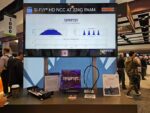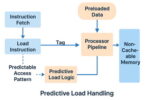Dr. Michael Förtsch, CEO of Q.ANT, is a physicist and innovator driving advancements in photonic computing and sensing technologies. With a PhD from the Max Planck Institute for the Science of Light, he leads Q.ANT’s development of Thin-Film Lithium Niobate (TFLN) technology, delivering groundbreaking energy efficiency and computational power for AI and data center applications.
Tell us about your company.
Q.ANT is a deep-tech company pioneering photonic computing and quantum sensing solutions to address the challenges of the next computing era. Our current, primary area of focus is developing and industrializing photonic processing technologies for advanced applications in AI and high-performance computing (HPC).
Photonic computing is the next paradigm shift in AI and HPC. By using light (photons) instead of electrons, we overcome the limitations of traditional semiconductor scaling and can deliver radically higher performance with lower energy consumption.
Q.ANT’s first photonic AI processors are based on the industry standard PCIexpress and include the associated software control (plug-and-play solution) so they integrate easily into HPC environments as they are currently set up. We know it is critical for any new technology to get adopted.
At the core of our technology is Thin-Film Lithium Niobate (TFLN), a breakthrough material that enables precise and efficient light-based computation. Our photonic Native Processing Units (NPUs) operate using the native parallelism of light —processing multiple calculations simultaneously, dramatically improving efficiency and performance for AI and data-intensive applications.
Founded in 2018, Q.ANT is headquartered in Stuttgart, Germany, and is at the forefront of scaling photonic computing for real-world adoption.
What problems are you solving?
The explosive growth of AI and HPC is starting to exceed what is possible with conventional semiconductors, creating four urgent challenges:
1). Unmanageable energy consumption – AI data centers require vast amounts of power, with GPUs consuming over 1.2 kW each. The industry is now considering mini nuclear plants just to meet demand.
2). Processing limitations – Traditional chips rely on electronic bottlenecks that struggle to keep up with AI’s growing complexity.
3). Space limitations – Physical space constraints pose a significant challenge as datacenters struggle to accommodate the increasing number of server racks needed to meet rising performance demands.
4). Shrinking traditional GPU technology to the next smaller nodes demands massive investments in cutting-edge manufacturing, often reaching billions.
Q.ANT is tackling these challenges head-on, redefining computing efficiency by transitioning from electron-based to photon-based processing. Our photonic processors not only enhance performance but also dramatically reduce operational costs and energy consumption—delivering 30X energy savings and 50X greater computational density.
Also in manufacturing, Q.ANT has recently showcased a breakthrough: its technology can be produced at significantly lower costs by repurposing existing CMOS foundries that operate with 1990s-era technologies. These breakthroughs pave the way for more sustainable, scalable AI and high-performance computing.
What application areas are your strongest?
Q.ANT’s photonic processors dramatically enhance efficiency and processing power so are ideal for compute-intensive applications, such as AI model training, data center optimization, and advanced scientific computing. By leveraging the inherent advantages of light, Q.ANT enables faster, more energy-efficient processing of complex mathematical operations. Unlike traditional architectures, our approach replaces linear functions with non-linear equations, unlocking substantial gains in computational performance and redefining how businesses tackle their most demanding workloads.
What keeps your customers up at night?
Q.ANT’s customers are primarily concerned with the increasing energy demands and limitations of current data processing and sensing technologies. Data center managers, AI infrastructure providers, and industrial innovators face mounting challenges in performance, cost, and scalability and traditional semiconductor technology is struggling to keep pace. This is raising a number of urgent concerns such as:
- Increasing power demands – The cost and energy required to run AI at scale are becoming unsustainable.
- Processing power – AI workloads require ever-increasing computational power, but scaling with conventional chips is costly and inefficient.
- Scalability – Businesses need AI architectures that can grow without exponential increases in power consumption and operational expenses.
- Space – Expanding data centers to accommodate AI’s growing infrastructure is becoming increasingly difficult.
Q.ANT’s photonic computing solutions directly address these challenges by introducing a more efficient, high-performance approach that provides the following benefits:
- Radical energy efficiency – Our photonic processors reduce AI inference energy consumption by a factor of 30.
- Faster, more efficient processing – Native non-linear computation accelerates complex workloads with superior efficiency in cost, power, and space utilization.
- Seamless integration – Our PCIe-based Native Server Solution is fully compatible with x86 architectures and integrates easily into existing data centers.
- Optimized for data center space – With significantly fewer servers required to achieve the same computational power, Q.ANT’s solution helps alleviate space constraints while delivering superior performance.
By rethinking computing from the ground up, Q.ANT enables AI-driven businesses to scale sustainably, reduce operational costs, and prepare for the future of high-performance computing.
What does the competitive landscape look like, and how do you differentiate?
The competitive landscape is populated by companies exploring photonic and quantum technologies. However, many competitors remain in the research phase or focus on long-term promises. Q.ANT differentiates itself by focusing on near-term, high-impact solutions. We use light for data generation and processing, which enhances energy efficiency and creates opportunities that traditional semiconductor-based solutions cannot achieve.
Q.ANT is different. We are:
- One of the few companies delivering real photonic processors today
- Developing photonic chips using TFLN, a material that allows ultra-fast, precise computations without generating excess heat
- TFLN experts: with six years of expertise in TFLN-based photonic chips, and operating our own pilot line we have a significant first-mover advantage in commercial photonic computing.
What new features/technology are you working on?
We are focused on revolutionizing AI processing in HPC datacenters by developing an entirely new technology: analog computing units packaged as server solutions called Native Processing Servers (NPS). These servers promise to outperform today’s chip technologies in both performance and energy efficiency. They also integrate seamlessly with existing infrastructure, using the standardized PCI Express interface for easy plug-and-play compatibility with HPC server racks. When it comes to data center deployment requirements, our NPS meets the standards you’d expect from leading vendors. The same ease applies to software, existing source code can run on our systems without modification.
How do customers normally engage with your company?
Businesses, researchers, and AI leaders can contact Q.ANT via email at: native-computing@qant.gmbh and engage with the company in a number of ways:
- Direct purchase of photonic processors – Our processors are now available for purchase for experimenting and integrating into HPC environment.
- Collaborative innovation – We work with industry and research partners to develop next-gen AI applications on our photonic processors
- Community outreach – We participate in leading tech events to advance real-world photonic computing adoption.
With AI and HPC demand growing exponentially, Q.ANT is a key player in shaping the next era of computing.
Also Read:
Executive Interview with Leo Linehan, President, Electronic Materials, Materion Corporation









